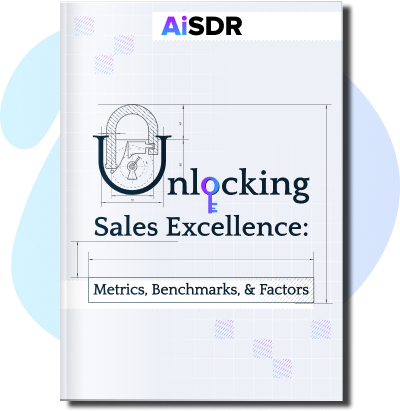85 Key Sales Statistics So You Can Sell Smarter, Not Harder

We created a list of 85 sales statistics to help you drive better outreach results and unlock greater performance.
We’ve mentioned multiple times how sales stats are the building blocks to better outreach and greater results.
Stats are also useful for staying on top of recent market trends and developments.
To give you a hand, we’ve compiled 85 key sales statistics to help you drive better sales performance.
Sales prospecting statistics
96% of sales prospects prefer doing their own research before talking to a salesperson. (HubSpot)
71% of prospects research information on their own instead of talking to a sales rep. (HubSpot)
88% of leads are already familiar with the company when first interacting with a sales rep, 84% know about their competitors, and 83% are aware of the brand’s products and services. (HubSpot)
72% of consumers are likely to switch brands to get better deals. (Salesforce)
76% remain loyal to companies providing optimal data security, while 72% value faster service. (Salesforce)
71.4% of companies report that less than half of their prospects are a good fit for their products or services. (Sales Insights Lab)
76% of top sales performers gather information on a lead before making contact. (LinkedIn)
85% of sales representatives say that AI improves their prospecting. (HubSpot)
98% of buyers research customer reviews and rating before selecting a vendor. (Gartner)
Omnichannel customers typically make 1.7x more purchases that single-channel customers. (McKinsey)
96% of marketers say personalization increases the chances of buyers making repeat purchases. (HubSpot)
94% of marketers say personalization improves sales results. (HubSpot)
71% of buyers looking for ideas to improve their business want to hear directly from sellers. (RAIN Group)
Sales follow-up statistics
48% of sales teams never attempt a follow-up after the first email. (Invesp)
75% of sales pros admit they don’t consistently follow their sales methodology. (Salesroom)
Only 2% of sales reps feel confident when engaging with leads, compared to 20% of managers. (Salesroom)
48% of sales reps don’t follow up after the first interaction with a prospect, missing potential opportunities to close deals. (Invesp)
Closing a deal requires five follow-ups after the initial call in 80% of cases. (Invesp)
35% to 50% of sales will likely go to the business that contacts interested prospects first. (Invesp)
57% of buyers are more inclined to buy from a sales rep who doesn’t pressure them in follow-ups. (Invesp)
60% of customers say “no” four times before saying yes to a sales offer. (Invesp)
Outbound sales statistics
28% of revenue in B2B comes from outbound, while 31% pours in from partner referrals. (Ebsta)
79% of sales professionals believe sales enablement content is essential for success. (HubSpot)
Most buyers (63-69%) are more willing to connect when a salesperson provides personalized content relevant to their business or industry. (RAIN Group)
58% of intro meetings bring no value to the prospects. (RAIN Group)
81% of sales reps find collaborative team selling effective in closing deals. (Salesforce)
80% of companies encourage their sales teams to prioritize long-term partnerships over short-term projects. (Salesforce)
Inbound sales statistics
Only 30% of sales pros see a strong alignment between marketing and sales in their companies. (HubSpot)
78% of sales professionals think their CRM improves the alignment between sales and marketing. (HubSpot)
59% of sales representatives confirm that leads they get from marketing are high-quality. (HubSpot)
According to 75% of marketers, personalizing the customer experience significantly drives sales. (HubSpot)
14% of ROI comes from email marketing. (HubSpot)
Sales email statistics
88% of people say they use email every day, with 39% saying they check their inbox 3-5 times a day. (ZeroBounce)
80% of clients prefer to communicate via email. (RAIN Group)
The average email open rate is 35.63%. (Mailchimp)
66% of people prefer short emails, 6% prefer longer emails, and 28% think email length isn’t important. (ZeroBounce)
Seven-word subject lines achieve the highest open rate at 46.2%. (Regie.ai)
61% of people check their email primarily on their mobile device. (ZeroBounce)
144-word email body copy has the best reply rate at 2.7%. (Regie.ai)
The number of email users is projected to reach 4.89 billion users in 2027. (Statista)
57% of webinar registrations occur through email. (GoToWebinar)
44% of people say the primary reason they unsubscribe from an email list is that they receive too many emails from the sender. (ZeroBounce)
Sales call statistics
74% of sales representatives report better response rates when making cold and warm calls. (HubSpot)
The success rate of cold calling is 4.82% in 2024. (Cognism)
Cold callers have a ~75% chance of the prospect answering on the first call attempt. (Cognism)
Sales performance statistics
58% of B2B companies are seeing longer sales cycles as customers try to stretch their budget and include more stakeholders. (Salesforce)
The average B2B sales cycle (by industry) lasts anywhere from 70 to 162 days, with retail being the fastest while non-profits take the longest. (Focus Digital)
54% of sales professionals report that this year’s sales are more difficult than last year. (HubSpot)
21% was a typical sales conversion rate in 2023. (HubSpot)
18% of sales reps call for cutting down on administrative tasks to improve efficiency. (Richardson)
86% of B2B customers are more likely to buy from vendors that take the time to get to know them. (Salesforce)
The average B2B sales cycle (by company size) lasts anywhere from 38 to 185 days, with companies of 1-10 employees being the fastest while companies of 10,001+ employees take the longest. (Focus Digital)
Almost 3/4 of B2B customers say their relationships with sales professionals feel transactional in nature. (Salesforce)
The top three challenges to staying on track are changing business cycles (15%), delivering resonant messaging to decision-makers (14%), and evolving customer needs (12%). (Richardson)
Completing SPICED (Situation, Pain, Impact, Critical Event, Decision) by the time a solution is presented to a client makes it 307% more likely to win a deal compared to the incomplete process. (Ebsta)
61% of deals were reported to be lost due to “indecision,” while other common reasons cited by average performers include limited budget (22%), low priority (20%), and competition (14%). (Ebsta)
24% of companies identify a lack of effective communication tools as the main bottleneck in achieving sales goals, 19% cite poor personalization, and 18% highlight challenges with handling objections. (Salesroom)
Sales professionals spend 70% of their working hours on tasks other than selling, such as email and lead management. (Salesforce)
69% of sales professionals are finding it increasingly difficult to close sales deals. (Salesforce)
The average return on investment of email marketing is $36 for every dollar spent. (Litmus)
The return on investment of email marketing can increase by up to 70% with the help of artificial intelligence. (HubSpot)
Sales teams are 103% more likely to perform better when they’re aligned with their company’s marketing team. (HubSpot)
Only 30% of sales teams feel that they’re aligned with their marketing team. (HubSpot)
52% of sales representatives believe that AI helps them connect with leads on a more personal level. (HubSpot)
Overall sales revenue is expected to hit $339.1B in 2024 and $818.8B in 2029. (Statista)
73% of B2B webinar attendees turn into qualified leads. (Zippia)
Sales technology statistics
45% of sales pros feel overwhelmed by the sheer number of tools they use. (HubSpot)
68% of sales reps find note-taking and CRM data input the most time-consuming manual tasks, with 43% spending between 10 and 20 hours weekly on these activities. (Salesroom)
Only 37% of sales pros strongly believe their company uses its CRM system to its full potential. (Salesforce)
On average, sales teams use 10 tools to make a sale. (Salesforce)
B2B customers looking to maximize the value of every purchase can take up to 6 months evaluating sales software before deciding whether to buy or not. (Gartner)
Sales AI statistics
81% of sales representatives say they can spend less time on administrative tasks thanks to AI. (HubSpot)
78% confirm that AI helps them be more productive. (HubSpot)
2 hours a day on average are saved with AI tech. (HubSpot)
63% of sales executives report a positive effect of AI on their competitive advantage. (HubSpot)
71% of sales reps use generative AI to automate communications, while 68% use it to design sales plans and strategies. (Salesforce)
49% of SDRs need more understanding of how to use gen AI safely. (Salesforce)
21% of commercial leaders have fully enabled generative AI for B2B buying and selling. (McKinsey)
63% of sales pros expect their company to provide some form of training on AI usage. (Salesforce)
95% of executives say their organization is using AI in sales in some capacity. (Salesloft)
15% of day-to-day work decisions may be made autonomously by AI by 2028 (Gartner).
84% of executives say their organization has used generative AI in sales in the past year. (Salesloft)
Sales AI could unlock trillions of dollars in value and productivity across many sectors. (McKinsey)
SDR & BDR statistics
The average salary for an in-house business development representative in the United States is $66K-$107K per year. (Glassdoor)
The cost of an in-house SDR can reach up to $139,120, after factoring in salary, on-target earnings (OTE), employment taxes, benefits, equipment, and software. (AiSDR)
What does this mean for AI in sales?
Even though SDRs and Account Executives are struggling to reach quota, the data shows that the sales industry is rapidly evolving and becoming more competitive.
As buyers increasingly do their own research and seek personalized approaches, generating meaningful marketing and sales content will remain a key focus for marketing and sales teams throughout 2024.
Another channel for growth is using AI sales tools that allow you to automate outreach and other time-consuming tasks. However, such tools are best used for setting the stage for a relationship – leaving you to forge it.











